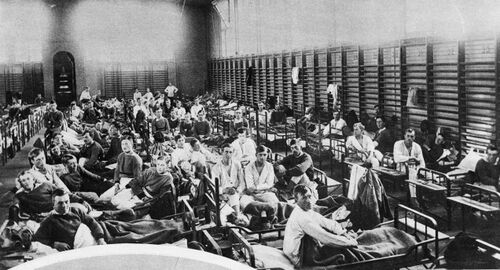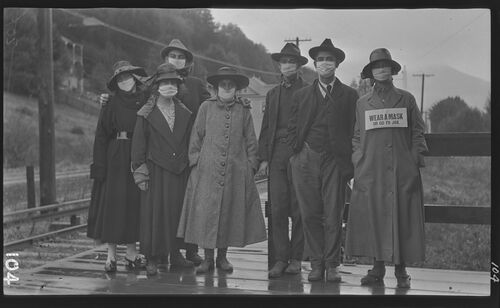Spanish flu
 At the regiment in Boden (Sweden), 1918. | |
| Date | January 1918 - December 1920 |
|---|---|
| Location | global |
| Deaths | 50000000 |
| Interest of | Eleanor McBean, Hans Tolzin |
| Description | A pandemic starting at the end of WW1, which killed perhaps 50 million |
The 1918 influenza pandemic (January 1918 – December 1920), colloquially known as Spanish flu was a deadly pandemic starting at the end of World War 1.
Official narrative
The Spanish flu was an unusually deadly influenza pandemic caused by the H1N1 influenza A virus. It infected 500 million people around the world, or about 27% of the then world population of between 1.8 and 1.9 billion, including people on isolated Pacific islands and in the Arctic.
The death toll is estimated to have been anywhere from 17 million to 50 million, and possibly as high as 100 million, making it one of the deadliest epidemics in human history. The CDC on it's website in the 2000s put it at 20 million worldwide, with 500,000 deaths in the US.[1]
Historical and epidemiological data are inadequate to identify its geographic origin with certainty.[2]
Concerns
Some, like Dr Gary G. Kohls, connect the 1918 flu to vaccine developments of the Rockefeller Institute for Medical Research at the time and conclude that the pandemic may have been a medical trial that went wrong.[3][4]
Hans Tolzin, who looked at available evidence found several notable points about the 1918 influenza pandemic, that in his view warrant attention:[5]
- The "Spanish flu" was not contagious; during corresponding human trials in Boston and San Francisco in the fall of 1918, not one of the test subjects fell ill due to normal infection, despite all efforts (like several sick people sneezing into the face of healthy people)
- Geographical origin and course of the pandemic are completely unclear and are based on unconfirmed individual reports, according to which the epidemic must have broken out even on several continents at the same time
- There were great differences in the course of the disease and its symptoms
- To this day, no one can explain why it was primarily healthy young adults who were affected - and not the weak and elderly, as one would think
- While today it is believed that the Spanish flu was caused by an influenza virus, in 1918 mass vaccination against a bacterium (Haemophilus influenzae) was carried out - allegedly with great success.
- Many contemporaries saw a connection between the mass vaccinations of that time (especially against smallpox and typhoid) and the waves of illness that immediately followed. According to eyewitnesses, only vaccinated people fell ill with the "Spanish flu"
- To this day, the mass vaccinations of that time (against "influenza", among others) are not discussed and their possible connection with the "Spanish flu" is not reappraised
- Historians today are surprised that the circumstances of the "Spanish flu" were more or less hushed up in publications by doctors of the time
External links
- Bacterial Pneumonia Caused Most Deaths in 1918 Influenza Pandemic - NIH 2008
- The 1918-19 Spanish Influenza Pandemic and Vaccine Development
- Reuters - fact-check: False claim: the 1918 influenza pandemic was caused by vaccines
- Hans Tolzin interviewed for the Corona Investigative Committee about his findings on the Spanish flu:
- Debunking 5 popular (and false) notions about the 1918 Spanish Flu
Related Document
| Title | Type | Publication date | Author(s) | Description |
|---|---|---|---|---|
| Document:Momento Mori – Unpopular Thoughts on Corona Virus | blog post | 7 March 2020 | Craig Murray | Consider this: 100% of those who contract COVID-19 are going to die. 100% of those who do not contract COVID-19 are also going to die. The difference in average life expectancy between the two groups will prove to be only very marginal. That is because the large majority of those who die of COVID-19 will already be nearing the end of life or have other health problems. |
References
- ↑ http://web.archive.org/web/20000609011958/http://www.cdc.gov/ncidod/diseases/flu/fluinfo.htm
- ↑ "La Grippe Espagnole de 1918"
- ↑ https://www.lewrockwell.com/2020/07/gary-g-kohls/the-true-story-of-the-1918-so-called-viral-influenza-pandemic/
- ↑ http://archive.today/2020.12.12-174553/https://fort-russ.com/2020/05/did-psychopath-rockefeller-create-the-spanish-flu-pandemic-of-1918/
- ↑ https://web.archive.org/web/20200527140727/https://www.impf-report.de/download/impf-report_2005.pdf
